What is intermittent or continuous cardiac pain caused by anoxia of the myocardium called
Angina
What is the act of listening, either directly or through a stethoscope or other instrument, to sounds within the body as a method of diagnosis calledIE: lungs, heart, & abdomen
Auscultation
What is the removal of living tissue from the body for diagnostic examination called
Biopsy
What is a mobile unit used in surgery or at the bedside that produces "real time" fluoroscopic images for the surgeon, or radiographer called
C-arm
What is used in the anesthetic setting to provide a breath-by-breath analysis of expired carbon dioxide (end-tidal CO2)called
Capnography
What is the fluid that flows through the ventricles of the brain, subarachnoid space, and spinal canal; serves to protect these structures called
Cerebrospinal fluid (CSF)
What is a preoperative and intraoperative diagnostic tool in which a catheter is inserted into the common bile duct and contrast medium is injected to outline potential calculi under fluoroscopy called
Cholangiography
What is the solution injected into arteries, veins, or ducts during a radiographic exam that is radiopaque and therefore stands out in contrast to the surrounding tissues called
IE: Hypaque, Renografin, or Cystografin
Contrast medium
What is a solution that fills the hollow cavities of the brain, circulates around the brain and spinal cord, it provides nourishment, cushions, and removes wastes called
Cerebral Spinal Fluid
CSF
What is the insertion of an endoscope through the urethra and into the bladder for the purpose of viewing for treatment and diagnosis called
Cystoscopy
What is the abbreviation for electrocardiogram, which is a record of the electrical activity of the heart
ECG or EKG
What is the abbreviation electroencephalography. Display and recording of the brain’s electrical activity by measurement of changes in electric potentials
EEG
What is a quick preparation of a biopsy sample for examination during an actual surgical procedure to determines if a sample is benign or malignant. A pathological method of diagnosis that involves freezing a tissue sample, slicing it into thin sections, staining it, and then viewing it under a microscope
Frozen Section
What is the suffix for written record
Gram
What is the laboratory method of identifying bacteria; bacteria that stain purple are referred to as gram-positive, and bacteria that do not retain the stain and appear red in color are referred to as gram-negative
Gram Stain
What is the suffix meaning producing a drawing or writing
Graph
What is a substance or item that remains in place either permanently or for a period of time, for instance a Foley remains in place until the patient is able to completely void.
Indwelling
What procedure involves the intravenous injection of a radioactive isotope into the patient prior to an imaging study; also referred to as nuclear medicine study or radionuclide imaging
Isotope Scanning
What is the name of something that causes or forms a blockage or hindrance of a passage
Obstruction
What is the term for an examination technique in which the examiner's hands are used to feel the texture, size, consistency, and location of certain body parts. Examining by touch.
Palpation
What is an artificial device used to replace a body structure, aid bodily function, or give a cosmetic appearance; may be permanent or removable
Prosthesis
What is the process of recording Radiography; X-rays (radiation)
Roentgenography
What is the indication of a disease or condition perceived by the EXAMINER
Sign
What is the Indication of a disease or condition perceived by the PATIENT
Symptom
What is the use of high-frequency waves that are directed into the body and are reflected from the tissues to record an image for diagnostic purposes called
Ultrasonography
What is the laboratory examination of a urine specimen for diagnostic purposes
Urinalysis
What is an X-ray produced by the collision of a beam of electrons with a metal target within an X-ray tube
Radiography (Roentgenography)
What is the unit of energy
Penetrability of the X-ray beam
Joule
What does RADS refer to
Radiation Absorbed Dosage
What is directed from the front toward the back
Anteroposterior
For an X-Ray what radiographic views require that the film be placed underneath the patient
Anteroposterior (AP)
For an X-Ray what view demands placement next to the body
Lateral views
What is it called when the surgeon uses his eyes (no instruments) to look direct at something
Direct visualization
What is it called when the surgeon uses instruments, for instance otoscope/ophthalmoscope, laryngoscopy and bronchoscopy for viewing
Enhanced visualization
What is it called when a surgeon uses an instrument to help perform exams (pharyngeal mirror)
Indirect visualization
A radiographic examination of the breast to detect the presence of tumors or precancerous cells
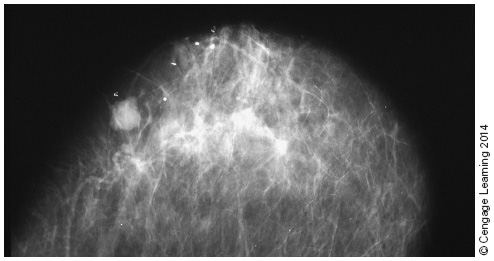
Mammography
What diagnostic procedure is performed to evaluate the spine for patients with neck, back, or leg pain.
Myelography
MRI is useful in imaging the spinal cord, nerve roots, and disks, BUT myelography has the added benefit of clearly outlining bone tissue, and for patients with metal implants
MRI vs Myelography
For a myelographic study to be performed what has to be injected into the cerebrospinal fluid at the lower lumbar level to outline the spinal cord and nerve roots
Contrast Medium
What diagnostic procedure is performed to identify osteophytes (bony spurs) or disk extrusions, along with a myelographic study
Computed Axial Tomography (CAT)
What diagnostic procedure utilizes X-rays to project images of body structures onto a monitor, the images may be viewed during movement and projected in “real time,” allowing the action of joints and organs to be viewed directly.
Fluoroscopy
The C-arm is frequently used in conjunction with a special radiographic table that allows X-rays to pass through the tabletop, which is referred to as being ........
Radiolucent
Angiography (including cardiac catheterization)
Cholangiography
Retrograde urography
Aid in bone realignment and prosthesis placement
Verification of catheter placement epidural/central venous pressure and lead pacemaker introduction
To direct instrumentation, neurosurgery/orthopedics
Fluoroscopy Intraoperative Applications
What diagnostic procedure remains the reference standard for assessing the cause and severity of peripheral vascular disease
Angiography
What is an invasive procedure that must be accomplished under sterile conditions
Angiography
What diagnostic procedure allows the visualization of most veins and arteries of the body following the intravenous or intra-arterial injection of a contrast medium, and are typically performed in a cardiac catheterization laboratory
Angiography
What are solutions that are injected into the arteries or veins during angiography that are not penetrable by X-rays (that is, they are radiopaque) and therefore stand out in contrast to the surrounding tissues during angiographic study.
Contrast materials
For an Angiography the ....... the radius of the catheter, the safer is the procedure
The smaller
What is the name for a method of percutaneous insertion of a catheter into a blood vessel or space. A needle is used to puncture the structure and a guide wire is threaded through the needle; when the needle is withdrawn, a catheter is threaded over the wire; the wire is then withdrawn, leaving the catheter in place.
Seldinger technique
What diagnostic procedure permits the evaluation of heart function, visualization of coronary arteries and cardiac chambers, to diagnose coronary artery, valvular, pulmonary, and congenital heart disease
Cardiac catheterization
What procedure refers to making an incision and dissecting through the tissue layers to expose the vessel and making an incision into the vessel for the introduction of the catheter
Cut-down
What refers to the percentage of blood that is pumped out of a filled ventricle with each heartbeat
Ejection fraction
What is a normal ejection fraction
55% to 75%
Right heart studies are accomplished with the aid of a balloon-tipped, ........... catheter attached to a transducer and monitor
Swan-Ganz pulmonary artery
What is this diagnostic tool that can be used preoperatively, and intraoperatively during cholecystectomy or common bile duct exploration, where a catheter can be inserted and contrast medium injected into the biliary system to outline calculi or other obstructions under fluoroscopy
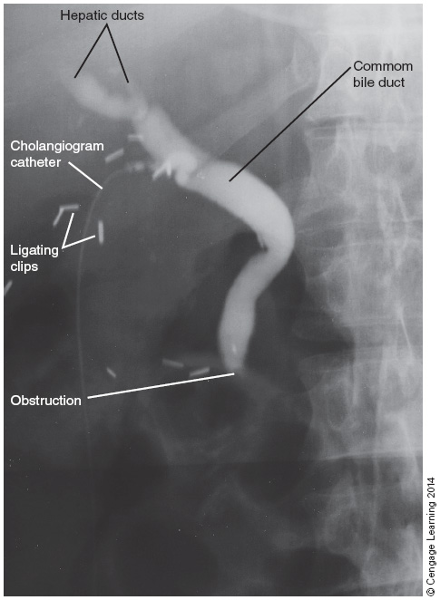
Cholangiography
What diagnostic procedure uses a specialized X-ray machine that produces pictures of a body part in “slices” for evaluation by a radiologist
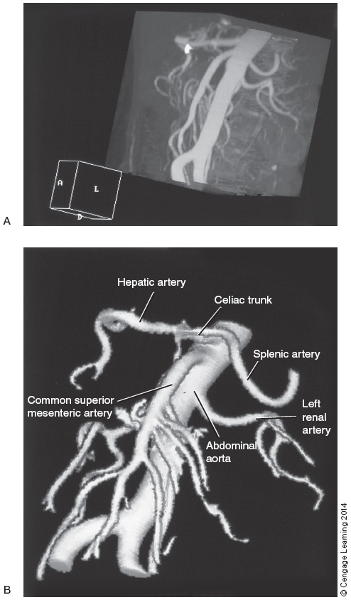
Computed Axial Tomography (CT or CAT scan)
What uses electromagnetic radiation to create an image from approximately 4,000 different tissue densities that are sorted into 16 different groups
A CT scan
What can sometimes be enhanced with the use of an iodine-based contrast medium, which is given to the patient intravenously, unless they are allergic to iodine
The CT image
As a neurological diagnostic tool, what is better than MRI for emergencies related to the brain because it is faster and better able to detect fresh bleeding
CT scanning
What combines CT and radioisotope brain scanning, and helps to identify how different areas of the brain function by highlighting chemical or metabolic activity
Positron Emission Tomography (PET scanning)
What uses two different forms of energy to create an image. A spinning hydrogen atom is placed into a magnetic field, forcing the atoms to line up and “spin” at a particular frequency
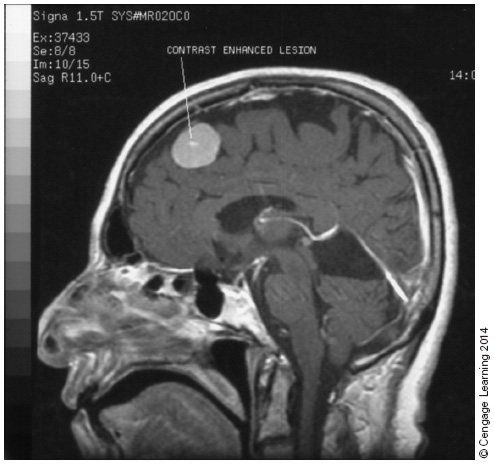
Magnetic Resonance Imaging (MRI)
What imaging tool allows slices to be taken from any direction, in addition to using NO X-ray radiation
MRI
What diagnostic procedure is especially good for imaging soft tissue, so it is often used for the evaluation of brain disorders and for providing images of a herniated disc and its relationship to the spinal cord
MRI
What diagnostic procedure uses high-frequency sound waves directed into the body and reflected from the tissues to a recording device for diagnostic purposes. Frequencies of 1-10 million Hz are necessary for diagnostic studies. The lower the frequency, the greater is the depth of sound wave penetration into the body.
Ultrasonography
What are produced when a crystal (transducer) is stimulated electrically. The beam that is produced is directed into the body and variances in tissue density are reflected back to the transducer as echoes
Ultrasonic waves
What is a useful diagnostic tool for examination of the heart and abdominopelvic cavity. It is also useful for identifying carotid artery stenosis.
Ultrasound
What diagnostic procedure is not used to examine the lungs because it's waves cannot pass through structures that contain air
Ultrasonography
What diagnostic procedure is a noninvasive study that provides a two-dimensional image of the heart by directing beams of ultrasonic waves from a sonar-like device through the chest wall
Echocardiography
What techniques of echocardiography are useful for mapping blood flow through the heart
Color Doppler
What diagnostic procedure is a slightly more invasive procedure, involves the introduction of a transducer attached to the end of a gastroscope into the esophagus, bringing the probe into closer approximation with the heart
Transesophageal Echocardiography (TEE)
What diagnostic procedure is used in the OR to determine the patency of arterial anastomosis
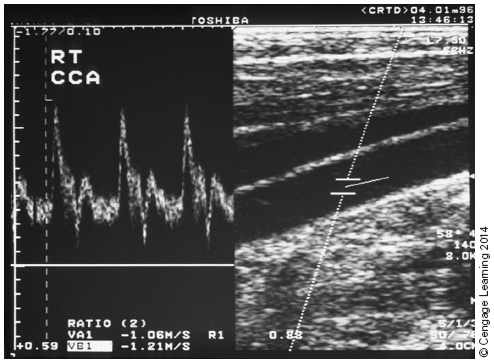
Doppler Ultrasonography
What diagnostic procedure examines the blood flow in the major arteries and veins in the arms and legs with the use of ultrasound (high-frequency sound waves that echo off the body). It may help diagnose a blood clot, venous insufficiency, arterial occlusion (closing), abnormalities in arterial blood flow caused by a narrowing, or trauma to the arteries
Doppler Ultrasonography
What diagnostic procedure is sometimes referred to as a nuclear medicine study or radionuclide imaging, involves the intravenous injection of a radioactive substance into the patient prior to the imaging study
Isotope scanning
Collections of isotopes in a certain area are referred to as a ....... and may indicate the presence of a pathological condition
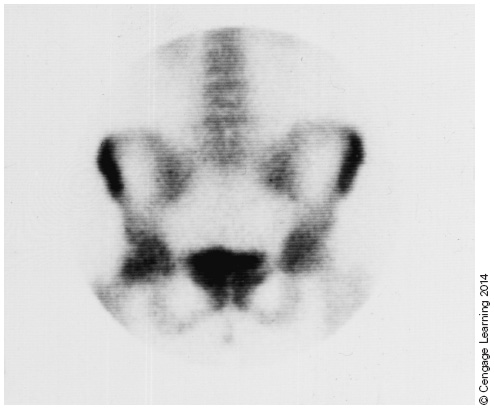
Hot spot
What therapy is used in predetermined doses to treat specific types of neoplasms that are susceptible to radiation by exposure to the radiation source
Radiation therapy
What kills cells by interfering with their metabolic activity
Radiation
What can be administered to the patient with a beam that passes through the tissue or by direct tissue contact with an implantable source
Radiation
What is the study called when venous or arterial blood is drawn from the patient for visual or computerized examination in the laboratory setting
Hematological Studies
What are these Hematology values for:
13.5–18 g/dL, 135–180 g/L (SI units)
Male Hemoglobin
What are these Hematology values for:
11.5–15.5 g/dL,115–155 g/L (SI units)
Female Hemoglobin
What are these Hematology values for:
40–52% (0.40–0.52)
Hematocrit Male
What are these Hematology values for:
35–46% (0.35–0.46)
Hematocrit Female
What are these Hematology values for:
5,000–10,000/mm3
White blood cells (leukocytes)
What are these Hematology values for:
0.25–0.5%
Basophils
What are these Hematology values for:
25–40%
Lymphocytes
What are these Hematology values for:
60–80% of lymphocytes
T-lymphocytes
What are these Hematology values for:
10–20% of lymphocytes
B-lymphocytes
Blood Gas Value
96–100% of capacity
Arterial Saturation
What involves cleaning the urinary meatus prior to voiding and “catching” the sample midstream into a sterile collection device
A clean-catch sample
What is a histologic examination
Study of tissue
What is a cytologic examination
Study of cells
What can have devastating effects for the patient. It could necessitate a second procedure to be performed to obtain another specimen and delay postoperative treatment, such as chemotherapy or antibiotic therapy.
The loss of a specimen
What must be correctly labeled. The STSR should confirm the identity of the specimen (name) and origin (left arm) with surgeon, and the circulator should confirm this information with the surgeon. Additionally, the orientation of the specimen becomes important when the margins of the wound must be proven to be free of tumor. The surgeon may mark the edges with suture and the STSR should accurately communicate the information to the circulator, e.g., “left breast biopsy, suture marker on superior quadrant of biopsy.”
Correct specimen labelling
What must NEVER be used for passing off and transporting a specimen
A counted sponge
What is the name of fluid with cells that are fixed on a microscopic slide, done during endoscopic procedures
Smear and Brush Biopsy
What is the removal of fluid through a needle attached to a syringe, for example fluid taken from a cyst, a joint such as the knee joint, a body cavity such as the peritoneal cavity, or a solid lesion in the breast, thyroid or lymph nodes
Aspiration biopsy
What is the name for the removal of a portion of the tissue mass or lesion for pathological study
Incisional biopsy
What biopsy section allows for an immediate diagnosis; however, the method is not 100% accurate and the final diagnosis is determined by the permanent section performed by the pathologist
Frozen section
What section analysis will the pathologist report the results directly to the surgeon in the OR via telephone. Sensitivity is required if the patient is under local anesthesia and awake
Frozen section
What sections are placed in a preservative such as formalin and sliced into thin sections by the pathologists, these findings are delivered after the case has concluded
Permanent sections
What must be sent to pathology dry. If a preservative is added it will dissolve the stones or permanently alter them.
Calculi (gallstones, kidney stones)
What are sent to the pathology department dry. They are carefully bagged and wrapped for transfer. They may be returned to the family if the patient passes for burial purposes
Amputated limbs
What must be handled carefully. Do not use forceps or clamps to handle them because the instrument could scratch the material
Bullets
What orthopedic implant should be kept dry and sent to pathology
Removed prostheses (orthopedic implants)
What bacteriological test is performed on tissue or fluid that is suspected of being infected, it may be cultured so that the pathogen can be identified and treated
Culture and sensitivity
Which bacteria die quickly if exposed to air
Anaerobic bacteria
What bacteriological test developed in 1844, remains a valuable tool in identifying bacteria
The Gram stain
Bacteria that retain the blue dye are called .......
Gram positive
Bacteria that fade to pink are
Gram negative
What bacteriological test involves the placement of a needle into a posterior portion of the pleural space for the analysis of pleural effusion
Thoracentesis
What procedure elevates fluid accumulations within thoracic cavity
Therapeutic thoracentesis
What are the studies described as "The body consists of cells that contain polarized molecules, and the communication systems of the body are bioelectrical or biochemical. Microelectrical impulses can be measured and provide useful diagnostic information:
Electrodiagnostic Studies
What is a valuable tool for the detection and evaluation of all forms of heart disease, especially myocardial infarction
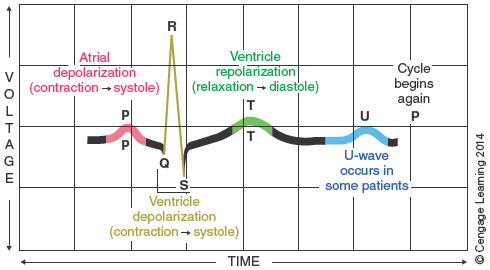
Electrocardiogram (ECG)
What is performed by placing a number of electrodes in predetermined locations on the skin of the arms, legs, and torso to record the electrical activity of the heart.
Electrocardiography
What allows 24-hour monitoring for asymptomatic and symptomatic dysrhythmias
The Holter monitor
What is a display and recording of the electrical activity of the brain by measurement of changes in electric potentials
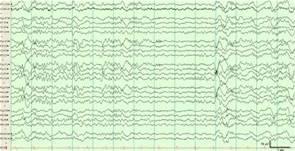
Electroencephalography (EEG)
What is used to help diagnose seizure disorder, brain tumor, epilepsy, and other diseases and injury to the brain. In addition, it is used intraoperatively during certain cranial, spinal, and vascular procedures for monitoring of neurological function.
Electroencephalography (EEG)
What is the study and recording of the electrical activity of skeletal muscle. Electric stimulation is applied to the muscle via a probe that is inserted through the skin into the muscle. Information about muscle contractility and inner-vation can be assembled.
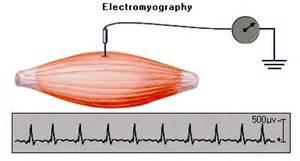
Electromyography (EMG)
What is a test used to measure the oxygen level (oxygen saturation) of the blood
Pulse Oximetry
What is the normal oxygen saturation in percentages
95%-97%.
What is the normal blood pH range
7.35 and 7.45
What was designed to estimate arterial levels of carbon dioxide noninvasively for surgical patients requiring mechanical ventilation
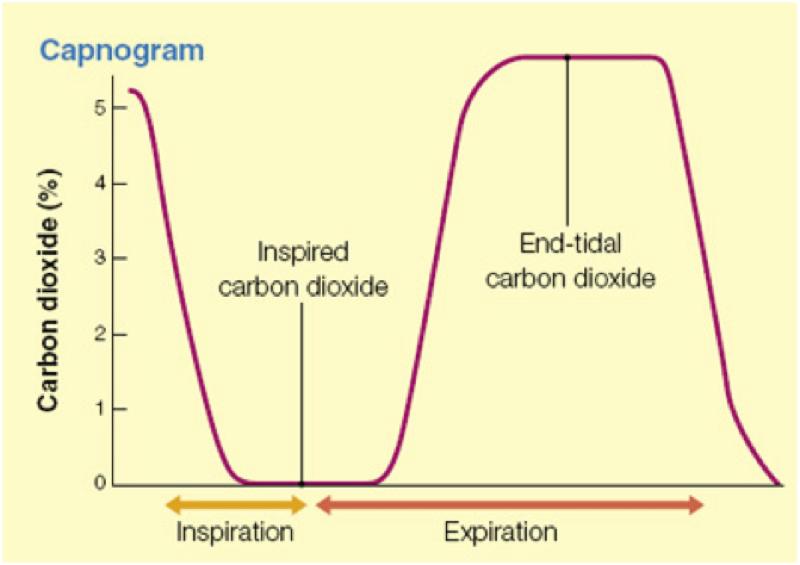
Capnography
What is the name for the level of carbon dioxide released at the end of an exhaled breath (expiration)
end-tidal CO2
What is a functional test of the lungs
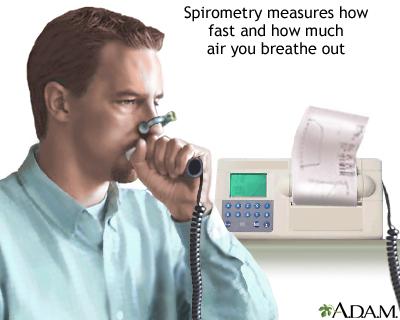
Spirometry
What is a useful test for detecting leaks in the ventilatory system and patient conditions such as chronic obstructive pulmonary disease (COPD) and adult respiratory distress syndrome (ARDS).
Spirometry
What is useful in patients with diffuse small vessel arterial disease, especially diabetics
Plethysmography
What is an instrument for determining and registering variations in the volume of an extremity and in the amount of blood present in the extremity or passing through it
A plethysmograph
What is a well-established technique for the noninvasive diagnosis of deep venous thrombosis of the lower extremity
Phleborheography